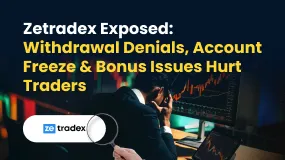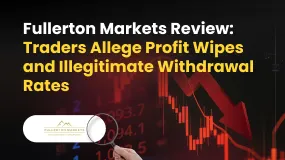简体中文
繁體中文
English
Pусский
日本語
ภาษาไทย
Tiếng Việt
Bahasa Indonesia
Español
हिन्दी
Filippiiniläinen
Français
Deutsch
Português
Türkçe
한국어
العربية
Best Stop-Loss Strategy for Forex Trading
Abstract:You need an effective plan to make profits and mitigate losses.

The sudden spikes in volatile markets and false signals can make trading challenging for any trader. This makes it all the more necessary to have tactics for effective profit taking and market exits when needed.
A stop loss order is an order to buy or sell a security when it reaches a pre-determined level. It is a tool that costs nothing to use and removes emotion from decision making. Stop loss orders are also good for protecting profit, and with them in place, you dont need to monitor your trades all the time.
Having such extensive usefulness makes stop loss order every trader's best friend, but the catch is that you need to know how to use it. Trading losses cannot be completely avoided with a stop loss order, and setting it wrongly can affect how successful your trades are.
The good thing is that the amount of loss you take can be minimized depending on how efficient your stop loss strategy for forex trading is.
Types of Stop loss orders
There are two types of stop loss orders:
Buy Stop Orders: A buy stop order directs a broker to buy an asset once a specific price has been reached. This type of order can be used in financial markets like the forex market and stock market. It is used to take advantage of an uptrend, but it can also protect against losses from an uncovered short position.
Sell Stop Orders: A sell stop order instructs a broker to sell a security once it reaches a pre-specified price level. The sell stop is usually lower than the market price of the given security, and it is used to protect accumulated profit from losses. When using a sell stop order, slippage can occur if the market price of the security continues to drop before it can be sold for the stop price.
Some forex brokers may provide more advanced orders that will ensure that the asset is sold for the exact price set by the trader. Each broker will have its own set of order options available, and it is important to review those options before deciding on a brokerage platform.
Difference between stop loss and stop-limit
Stop loss and stop limit are risk management tools that are used in trading. Because of their similarity, it is easy to confuse one for the other but they differ in a number of ways:
Stop loss order
Stop-loss orders are typically used to sell or buy a security when it reaches a certain price level. When the pre-determined price level is reached, the stop-loss order becomes a market order and is executed immediately.
For instance, if you own a security that sells for $15, you can set a stop-loss order at $13 if the asset has been experiencing a decrease. With the order set, your asset will immediately be put up for sale once it falls to $13. A Stop-loss order doesn't guarantee that your asset will sell for the pre-determined price as that depends on the price movements before the asset can be sold.
Lets say that by the time your security sells, its price falls to $11.90. That will be the price your asset will sell for. You can also rely on signal providers to give stop loss placement recommendations and provide accurate buy signals for trades.
This is why financial experts at Almvest.com list forex signal providers that also give stop-loss recommendations to help you take advantage of the most profitable opportunities in the market. A Stop-loss order also doesn't consider changing circumstances, and the order will still be executed even if the asset rebounds higher.
Stop Limit
A stop-limit order is quite similar to a stop-loss order, but instead of just the stop price, it also specifies the stop limit price. A stop limit order will only sell an asset for the set price or higher.
For example, if you set the stop price at $13 and the limit order at $11.50 and the asset falls below the stop price, the asset will only be sold at the limit price or higher. It will not be triggered if the security falls below the limit price.

A stop limit order gives you more flexibility and is used to protect trades in highly volatile markets. But it does come with some liability as it will not be executed if the price continues to fall below the limit price and doesn't recover. In this case, your losses would have increased rather than reduced, which was the original intention.
Both orders have their ups and downs, and the type you use can make a difference in your trade. So, it is necessary to get to know the different orders, test them with your strategy, and see which one will be the best fit.
What Is the Best Stop-Loss Strategy for Forex Trading?
The purpose of a stop loss order is to keep your trade active until it is no longer profitable to do so. It is advisable to be logical when placing a stop loss and do it in such a way that it allows for some market fluctuation.

Most traders target nothing more than a 2% loss on trades and place stop-loss to reflect that stance, but you can adjust this to suit your trading strategy. Another common method for setting stop-loss is to place them at recent swings. When opening a long position (or a buy position), the stop loss order can be placed below the most recent swing low. The same applies when entering a short position, as the stop loss order can be placed close to the recent swing high.
But there are other ways to determine where your stop loss order needs to be:
1. Protect your gains with a trailing stop
While stop loss is commonly used to control losses, implementing it as a trailing stop is a way to gather profits in the forex market. The trailing stop moves along with price action from a fixed distance while maintaining the loss percentage you set earlier.
Suppose a trader took a long position on an asset at $20 and set the initial stop loss at $18. If the price moves up, the stop loss can be adjusted to the starting capital of $20 to break even if the market should pull back.
The trailing stop is useful to traders who want to allow their positive positions to run for as long as possible and still guard against market reversals.
2. Using technical indicators to determine static stops
The technical indicators themselves can also be used as stop loss levels. Traders can use larger trend analysis as the basis for using indicators for stop loss, but volatility is another tool that can be employed for this purpose. Setting up static stops can be done with these indicators:
Average True Range: One of the indicators traders use to set stop loss orders is the Average True Range, which indicates price movement over a given time (it reads the volatility of an asset). The value of the ATR rises and falls depending on volatility levels.
The tricky part of using the Average True Range for setting stops is learning how to read it because the stops are set based on the ATR reading. When using this indicator, it is preferable to set the stop at the value of the ATR when you initiated the trade. Traders who want a more aggressive approach can set multiple stop loss orders at different ATR levels.
Fibonacci retracement: Another indicator that can be used for determining stops is the Fibonacci retracement. To use this tool to effectively place stop loss is to place it after the next retracement level. For instance, if you wanted to enter the market at the 50.0% Fibonacci retracement level, then your stop loss order should be placed past the next level, which would be 61.8%.
When doing this, the initial retracement level will act as the resistance point, and the trade will be invalidated if the price rises above the resistance. But this method depends on how accurate your entry is.
3. Setting multiple stops
Some traders use this strategy to protect their trade from sudden pullbacks or unexpected reversals. Although it is not possible to completely avoid losses with this strategy, it can still reduce the losses that would have occurred in the trade otherwise.
Conclusion
There aren't any rules set in stone when it comes to placing stop loss orders. Where you place a stop is a strategic choice based on your capital, risk appetite, and the accuracy of the information obtained from technical indicators.
You should also consider your overall strategy, the order options afforded to you by the brokerage platform, and your familiarity with other order types before you decide on a stop loss strategy.

Disclaimer:
The views in this article only represent the author's personal views, and do not constitute investment advice on this platform. This platform does not guarantee the accuracy, completeness and timeliness of the information in the article, and will not be liable for any loss caused by the use of or reliance on the information in the article.
Read more

VARIANSE Review: Traders Raise Deposit & Withdrawal Issues and High Commission & Swap Charges
Are you losing both while depositing and withdrawing your capital at VARIANSE? Does the broker give the currency conversion rate excuse for this? Have you been trapped with spreads charged higher than promised? Do you bear steep commission and swap charges at this broker? Traders frequently report these trading issues online. In today’s VARIANSE broker review, we have shared some trading complaints that have grabbed everyone’s attention. Take a look.

Is Fyntura a Regulated Broker? A Complete 2025 Broker Review
Fyntura is a broker accused by many users of posting fake reviews and running paid promotions with influencers to attract unsuspecting traders. Several users have faced withdrawal issues, blocked accounts, and manipulated trades. These are the real complaints and experiences shared by traders online. In this latest Fyntura Review 2025, you’ll learn about genuine user feedback, reported issues, and the broker’s credibility helping you make a better trading decision.

Zetradex Exposed: Withdrawal Denials, Account Freeze & Bonus Issues Hurt Traders
Do you constantly face withdrawal denials by Zetradex? Does the forex broker keep freezing your account and wiping out your capital? Have you also undergone issues concerning the Zetradex no deposit bonus? These trading issues have become apparent as the forex broker allegedly scams traders all over. In this Zetradex review article, we have demonstrated some complaints. Read them to get a feel of what happens to traders here.

Fullerton Markets Review: Traders Allege Profit Wipes and Illegitimate Withdrawal Rates
Have you witnessed constant profit deletion from Fullerton Markets? Has the Saint Vincent and the Grenadines-based forex broker wiped out all your capital after you checked it on Fullerton Markets Login? Do you find the deposit and withdrawal rates abnormal here? These complaints have been grabbing everyone’s attention on Fullerton Markets Review Platforms. In this article, we have shared some of these complaints for you to look at and inspect. Read on!
WikiFX Broker
Latest News
BASF CEO: EU CO₂ Trading Is A "Destruction Mechanism" For European Industry
Is Forex Zone Trading Regulated and Licensed?
PINAKINE Broker India Review 2025: A Complete Guide to Safety and Services
Exness Restricted Countries List 2025 Explained
Is Uniglobe Markets Legit? A 2025 Simple Guide to Its Safety, Services, and User Warnings
Is Inzo Broker Safe or a Scam? An Evidence-Based Analysis for Traders
WikiEXPO Dubai 2025 “Welcome Party” Kicks Off Tonight!
He Trusted a WhatsApp Group and Lost RM659,000
Is Fyntura a Regulated Broker? A Complete 2025 Broker Review
Zetradex Exposed: Withdrawal Denials, Account Freeze & Bonus Issues Hurt Traders
Currency Calculator



